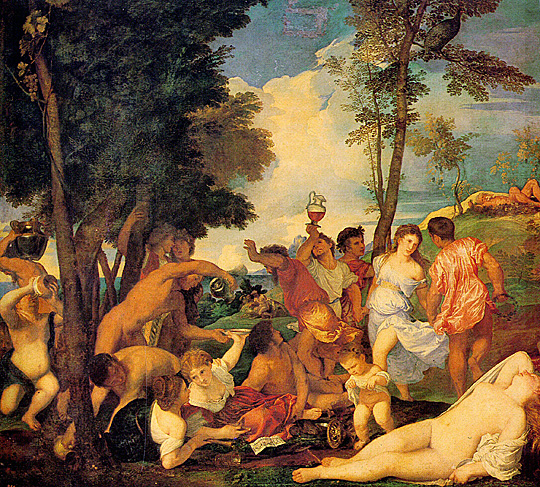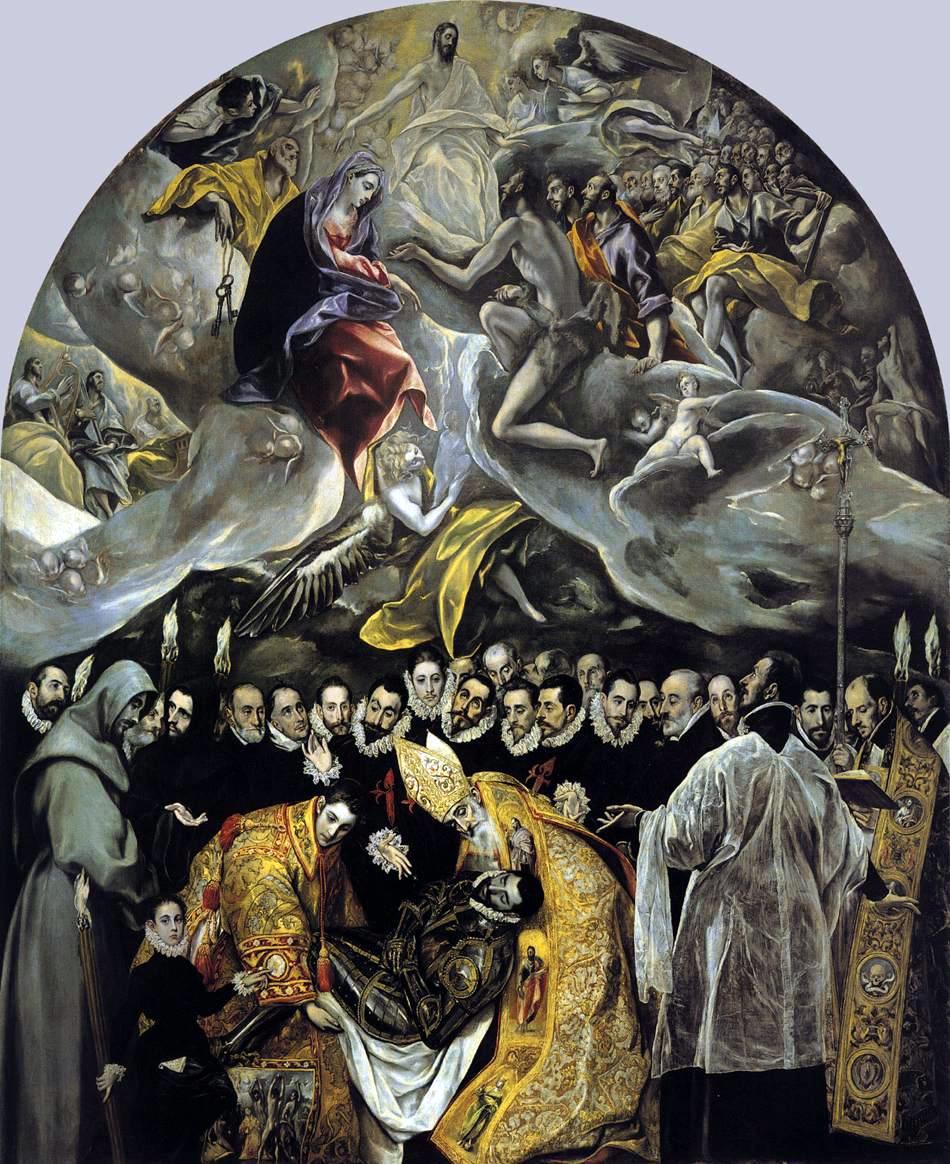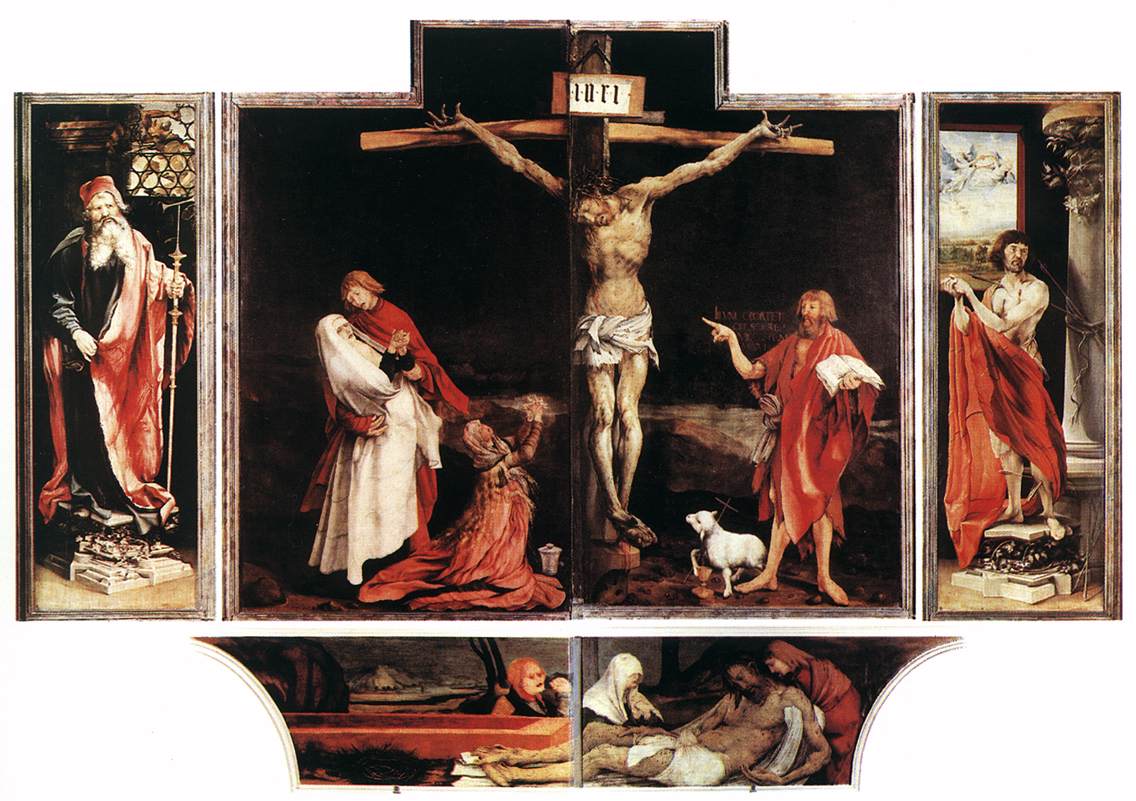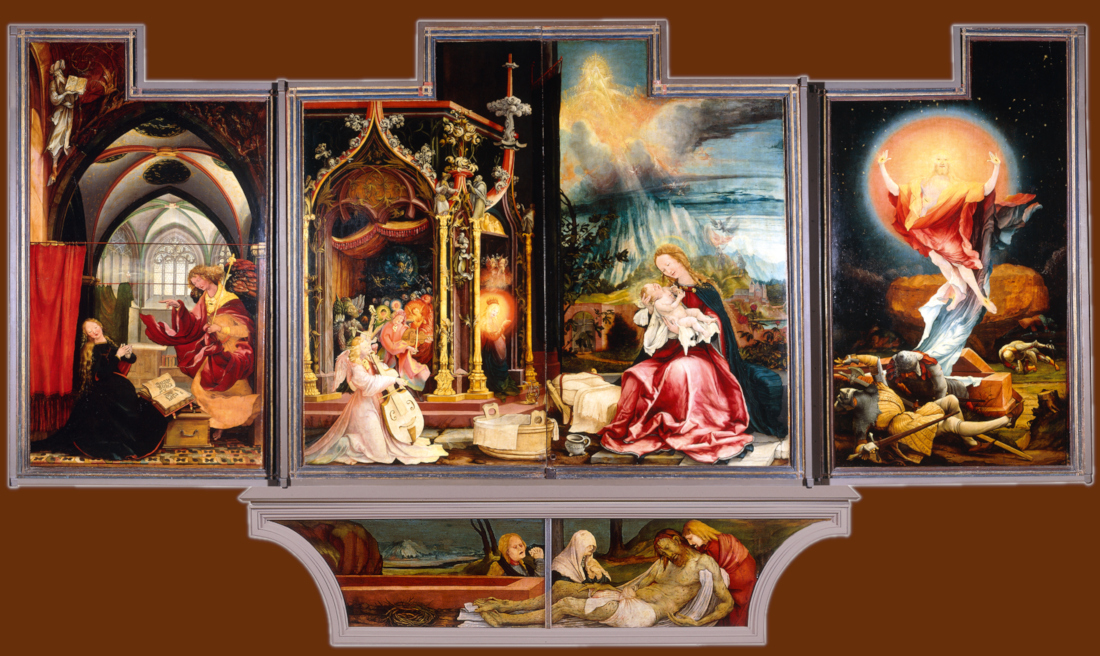Cards In This Set
| Front | Back |
 ? |
Titian, "Bacchanal," 1518. Oil on canvass-1 out of 4 seasons (summer)-intentionally sensuous-wine=summer-reclining nude figure in the foreground = acceptable because it's in a mythological setting
|
 ? |
Titian, "Venus of Urbino," 1538.-Commissioned by Duke of Urbino-depicted in upper-class home so becomes controversial b/c sexual-could be prostitute, new wife, mythological-puppy represents fidelity (why associated with marriage portrait)-2 maids are digging through cissone (marriage chests) which contain dowry-image created through gradations of light (Venetian manner contrary to that of Florence-Botticelli's "Birth of Venus"
|
 ? |
Tintoretto (Jacopo Robusti), "The last Supper," 1594-interested in complex compositions-more energetic than Michelangelo's or Titian's-placed in dining hall in San Giorgio Maggiore, looks like friars' dining hall continues into the painting-last major work, painted the year he died-at the cusp of the Mannerists (goal=break away from traditions of Italian Renaissance), beginning of Baroque (contrast between light and dark)-calm of Da Vinci's interrupted bc Christ is not centered, table is not in picture plane-dynamic, activated image-seems like a contemporary dining hall with contemporary servants and maids (uncommon of scene of Last Supper bc earthly figures included)-clouds of angels flying in-light hilights religious figures, mundane figures left in dark. Christ = light of the world, brightest around his head
|
 ? |
Parmigianino-self-portrait-presentation piece to Pope Clement VII to show his skill, considered the new Raphael in Rome-depicted modestly-distortion of image bc looking into convex mirror-painted on special canvass made in convex shape
|
 ? |
Parmigianino, "The Madonna with the Long Neck," 1535-Virgin and Child but reflection of Michelangelo's Pieta image (Virgin Mary holding dead son after crucifixion) - Child is laying down, sleeping, large-most famous painting, left unfinished at his death-in Baroque period oval shape becomes most important-ancient greek vessel in foreground echoes shape of Virgin's body, oval shaped head, oval shaped body-column behind Virgin associated with immaculate conception but also Christ being tied to column and flagellated/tortured before executed-tiny prophet figure holds a scroll in lower corner, foretelling death of Christ-composition is not balanced, stable, or calm-viewer feels anxious bc Christ is about to fall off of Mary's lap-one side full of figures, other side empty
|
 ? |
Bronzino, "Venus, Cupid, Folly and Time," 1546-commissioned by d'Medici as gift to ruler of France (Francis I)-complex allegory and composition-meant to be strange-depicted in flat/narrow plane, blue curtain is immediate backdrop-Father Time (bald) represents -Fraud, masked face upper left, flawed love-Cupid and Venus - "incestuous embrace" - steals her crown-Venus draws us in bc beautiful but artificial (cold, white marble statue)-about artifice, masked empty love, appearance-Folly is one with roses-Jealousy tearing his hair-little girl behind Folly represents bittersweet quality of love (head on a serpent body, distorted hand looks disconnected from body)
|
 ? |
Giovanni da Bologna, "Rape of the Sabine Women," Loggia dei Lanzi, Piazza della Signoria, Florence, 1583-artistic experiment - dynamic, twisted composition-meant to walk around on both sides-title given later (not at all intention of work)-Romans stole Sabine women-contrasts with still/calm of Michelangelo's "David"-activating figures, moving through space, projection of limbs
|
 ? |
El Greco, "The Burial of Court Orgaz," Church of Santo Tome, Toledo, Spain, 1586-trained as icon painter, moved to Venice and influenced by Titian and Tintoretto (stark contrast of light and dark)-emphasizes Catholic idea that Good Works are required to get into heaven (counter-reformation work)-Count Orgaz is Medeival figure buried in 1483, claim that St. Stephen and Augustin appeared at burial-scene is 16th century Spain, includes important Church members-3 layers-1. count being lowered into grave-2. worldly level, depiction of historic event-3. celestial realm, representation of heaven (etherial, smoky, elongated bodies, angels=clouds)-painting style in layers is very different, should be clear distinction btw real and sacred, we should not look at heavenly figures and believe they are real people-filled entire wall w/tomb slab below-viewer's position taken into account; supposed to stand very close and look directly up
|
 ? |
Palladio, Villa Rotonda, Vicenza, 1567-70-still adheres to classic Roman and Renaissance ideals (no Mannerist architecture)-architecture should be governed by rules/reason-wrote "The Four Books on Architecture" in 1570 - more practical than other treatises-buildings adhere to his theory more than other architects-country resident built for humanist-square block surmounted by round dome, portico/entry on each side (every side has different view, point is to view countryside)-round dome similar to Pantheon-circle and square = 2 most important shapes
|
 ? |
Hieronymus Bosch, "The Garden of Earthly Delights." 1505-1510.-Possible Bosch was in a religious sect-probably knew Ghent altarpiece, mystical land of Christ, same panorama of landscape but human/animal life-Inspired my Medeival texts, alchemy, grotesque, illustration of witchcraft, bestiaries-Doesn't conform to Italian ideals of perspective (giant birds) but linear perspective and aerial perspective utilized-use of space and light, observation of natural world (even if used to create a fantasy image)-Creation of Eve-Garden of Earthly Delights: Is it paradise? ravens/owls (witchcraft) suggest otherwise. Carnal pleasure, exotic delicacies. Fountain of Life in the center (perverse/erotic)-Hell: you pay for the indulgence of your carnal appetites. Person in center is a portrait (could be a self-portrait). Devil uses music to lure your soul by lowering self-discipline and awakening too many sensual pleasures. Eggs are alchemical symbols of Creation/sex, rats are symbols of falsehood, dead fish symbolize past memories. Nun pig says church is not above sin. Gambler impaled with cards.-oil: extraoridinary quality of details (like Van Eyck) but explosion of imagination-inspired Dali-deeply pessimistic (fear/anxiety of afterlife, soul searching)
|
 ? |
(CLOSED) Matthias Grunewald, "Isenheim Altarpiece." Chapel of the Hospital of St. Anthony, Isenheim, 1510-1515.-Mary Magdalen, John the Baptist-expressive representation of Christ in agony on the cross-body is distorted to communicate emotion-physical agony/tortures and emotional responses of those who loved Christ-posed against a black sky-low horizon line-light used to model shape of figure-proportions are not idealized like Italians-like foreshortened Christ by Mantegna, wounds directly in your face so you have to be aware of the suffering of the man who died for your sins-hospital devoted to victims of St. Anthony's disease caused by fungus on rye bread, cause hallucinations and gangreene of the limbs, feel like they are burning alive at the stake
|
 ? |
(OPEN) Matthias Grunewald, "Isenheim Altarpiece." Chapel of the Hospital of St. Anthony, Isenheim, 1510-1515.-Annunciation, Music-Making Angels (nativity), Virgin and Child, Resurrection-would only be open at certain times (holidays, festivals)-resurrection promises patients redemption after their suffering-vibrant, iridescent colors intended to give peace, calm, grace and joy of the rising Christ-Northern artists more interested in incorporating aspects of daily life (tub, like Merode triptych), gives you more access to Christ
|
 ? |
(OPEN) Matthias Grunewald, "Isenheim Altarpiece." Chapel of the Hospital of St. Anthony, Isenheim, 1510-1515.-sculpture (polychrome, guilded) only seen on highest of holy days-typical of Northern altarpieces to have sculpture on the inside-St. Anthony meeting with St. Paul in the desert on the left, temptation of St. Anthony on the right-scene of supernatural intensity like Bosch, saint being tortured by the animals-person with boils seems to be suffering from St. Anthony's disease
|
 ? |
Durer, "Self Portrait at Age 33," 1500.-began as printmaker-Northern artist to achieve international fame in his 20's-writer, intellectual-self portrait as Christ (but not an uncommon trope), prophetic mission of the artist, artist experience sacrifice/suffering, obligations and moral responsibility of artist-very famous for nature drawings
|
 ? |
Durer, "Hare," 1502, watercolors-exact representations of nature-later incorporated into paintings-signed and dated drawings so considered finished
|



